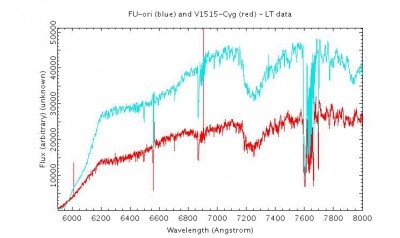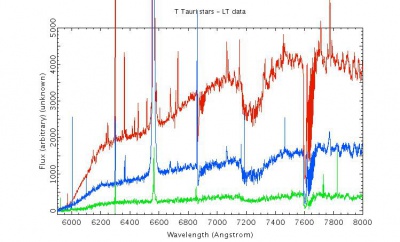Difference between revisions of "Triggers:TTau"
Chris.davis (talk | contribs) |
Chris.davis (talk | contribs) |
||
| Line 2: | Line 2: | ||
[[File:figure_ttau_mag.png|400px|right|thumb|T Cha - example of TTau star from the ASAS data]] | [[File:figure_ttau_mag.png|400px|right|thumb|T Cha - example of TTau star from the ASAS data]] | ||
| − | T Tauri type stars are very young (<math> <10^7 </math> y), low mass (<math> <3 M^{}_\odot </math>) pre-main sequence objects [http://adsabs.harvard.edu/abs/1989A%26ARv...1..291A Appenzeller & Mundt 1989]. | + | T Tauri type stars (TTSs) are very young (<math> <10^7 </math> y), low mass (<math> <3 M^{}_\odot </math>) pre-main sequence objects [http://adsabs.harvard.edu/abs/1989A%26ARv...1..291A Appenzeller & Mundt 1989]. They are optically visible (spectral type F,G,K,M) and their spectral energy distributions possess a modest excess in the near- and mid-IR, although the slope of their SED in the IR is still negative. Classical TTSs (Class II Young Stellar Objects) exhibit strong forbidden emission lines from ionised oxygen, sulphure, iron, etc., and are often associated with Herbig-Haro jets. |
Characteristics: | Characteristics: | ||
| Line 10: | Line 10: | ||
* absolute magnitude range: M_V=? to ? mag | * absolute magnitude range: M_V=? to ? mag | ||
* typically do not require a trigger, but watch list of T Tauris would be useful | * typically do not require a trigger, but watch list of T Tauris would be useful | ||
| + | |||
| + | Some young pre-main-sequence stars have exhibited quite drastic episodic variations. FU Ori | ||
Below are sample optical spectra of classical T Tauri stars and two FU-ori type eruptive variables. | Below are sample optical spectra of classical T Tauri stars and two FU-ori type eruptive variables. | ||
Revision as of 10:31, 26 July 2013
T Tauri stars and other young variables and transients
T Tauri type stars (TTSs) are very young (<math> <10^7 </math> y), low mass (<math> <3 M^{}_\odot </math>) pre-main sequence objects Appenzeller & Mundt 1989. They are optically visible (spectral type F,G,K,M) and their spectral energy distributions possess a modest excess in the near- and mid-IR, although the slope of their SED in the IR is still negative. Classical TTSs (Class II Young Stellar Objects) exhibit strong forbidden emission lines from ionised oxygen, sulphure, iron, etc., and are often associated with Herbig-Haro jets.
Characteristics:
- irregular and quasi-periodic variations
- high amplitude (up to 5 mag)
- may have a phase of quiescence (see figure)
- absolute magnitude range: M_V=? to ? mag
- typically do not require a trigger, but watch list of T Tauris would be useful
Some young pre-main-sequence stars have exhibited quite drastic episodic variations. FU Ori
Below are sample optical spectra of classical T Tauri stars and two FU-ori type eruptive variables.


